What better time than spring to celebrate the beginning of a new era? With the season just days away, Princeton University has completed the 10-year renovation of its main campus library, the Harvey S. Firestone Memorial Library, and ushered in a new era for research and scholarship at Princeton.
Firestone Library, one of nine locations within Princeton University Library (PUL), opened in 1948 as the first large American university library constructed after World War II. Guided by 11 principles, the renovation of Firestone aimed to redefine, rethink and revitalize this hub of campus life.
The project focused on creating a building that is well-suited to support modern library services and contemporary approaches to scholarship, while also providing inspiring, flexible study and work spaces. The renovation also incorporated a number of sustainable features, greatly improving the energy-efficiency of the building.
In short: The goal was to transform Firestone Library into an innovative 21st-century library.
1
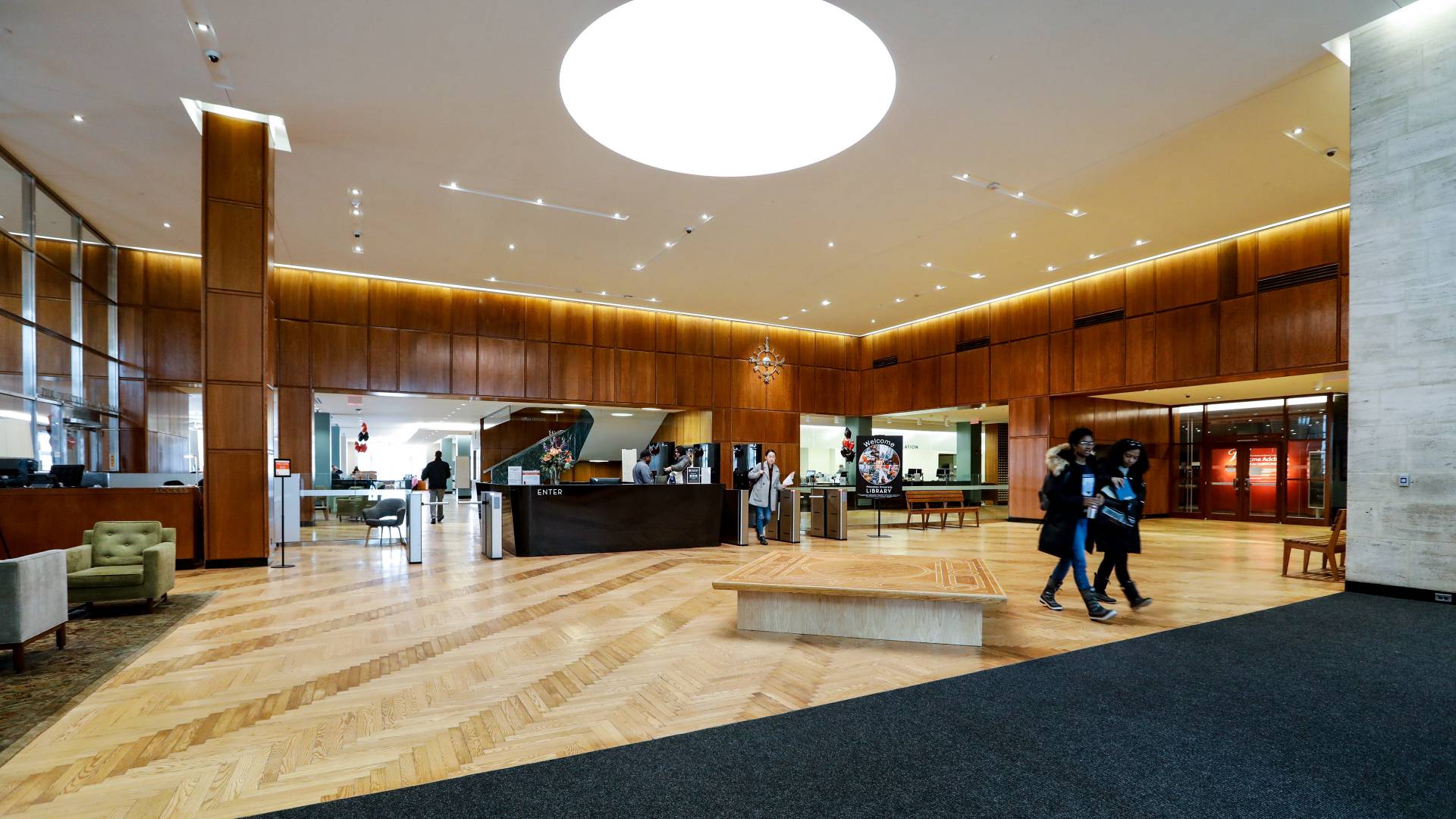
2
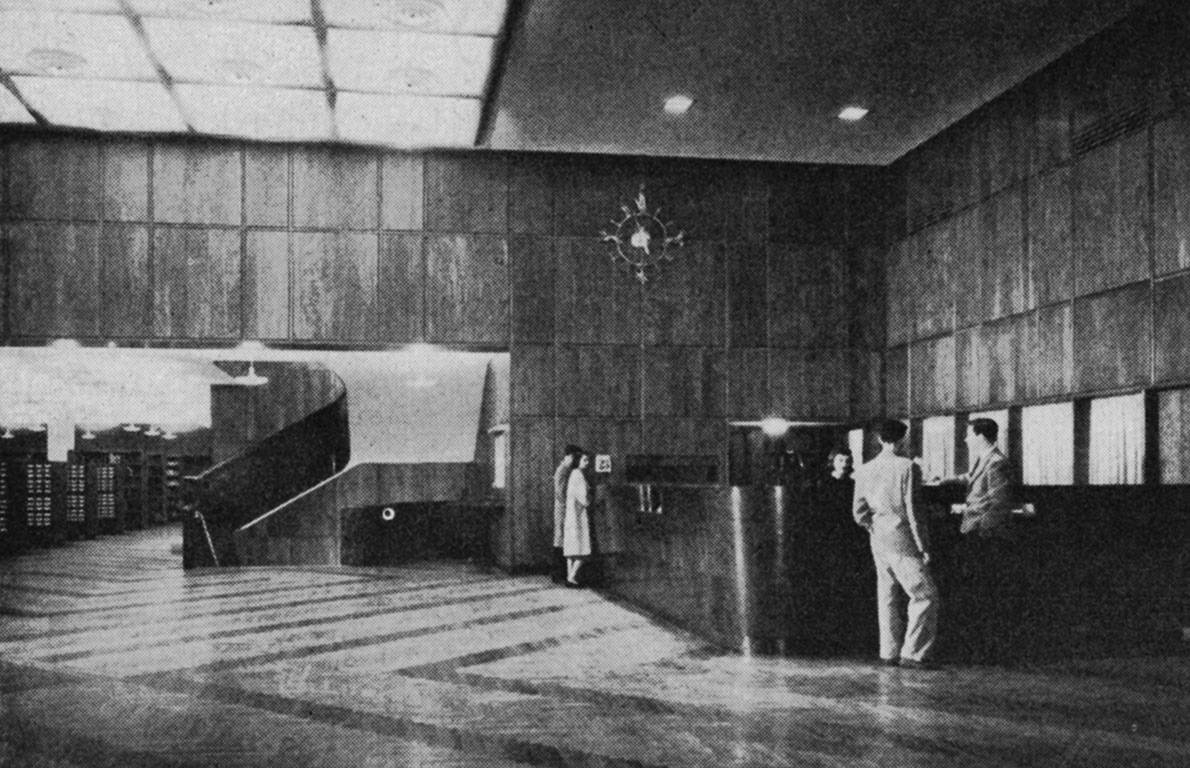
1
Visitors to Firestone Library step into a lobby filled with natural light. Firestone is the main campus library and one of nine locations within the Princeton University Library. Its collections are used by Princeton undergraduates, graduate students and faculty, as well as scholars and researchers from all over the world.
2
An archival photo shows the lobby inside Firestone Library after the building first opened in 1948. While the classic collegiate Gothic exterior of Firestone remains, the library’s recent renovation vastly changed the 430,000-square-foot interior.
“Firestone Library is undoubtedly one of the world’s great research libraries, but for me, and for many others on this campus, it is also a defining part of the Princeton experience,” Princeton President Christopher L. Eisgruber said. “I have been personally involved with the renovation project since its planning stages, when I travelled with [former] University Librarian Karin Trainer and various faculty members to visit other recently renovated university libraries. On those trips, I learned that libraries express the scholarly character of individual campuses. That is very true of Firestone, which attracts faculty, graduate students and undergraduates united by a shared mission of research and learning.”
Firestone is one of the largest open-stack libraries in existence. It assumes primary responsibility for Princeton’s humanities and social sciences collections and specialized research support services. The building also houses Rare Books and Special Collections, the Cotsen Children’s Library, the Scheide Library, and public exhibition galleries, as well as the new Center for Digital Humanities.
“Our Firestone has always been a powerful laboratory for the humanities and social sciences; it is now also a beautiful and inspiring home for scholars and the books they love,” Eisgruber said. “I am grateful for the vision of the architects, builders, staff and faculty who brought this renovation to life, and to all members of our community who supported this vital project. I hope that alumni will take the opportunity to visit Firestone when they return to campus; they will find spaces that bring back memories of their time on campus and evoke new appreciation for the wonders of learning.”
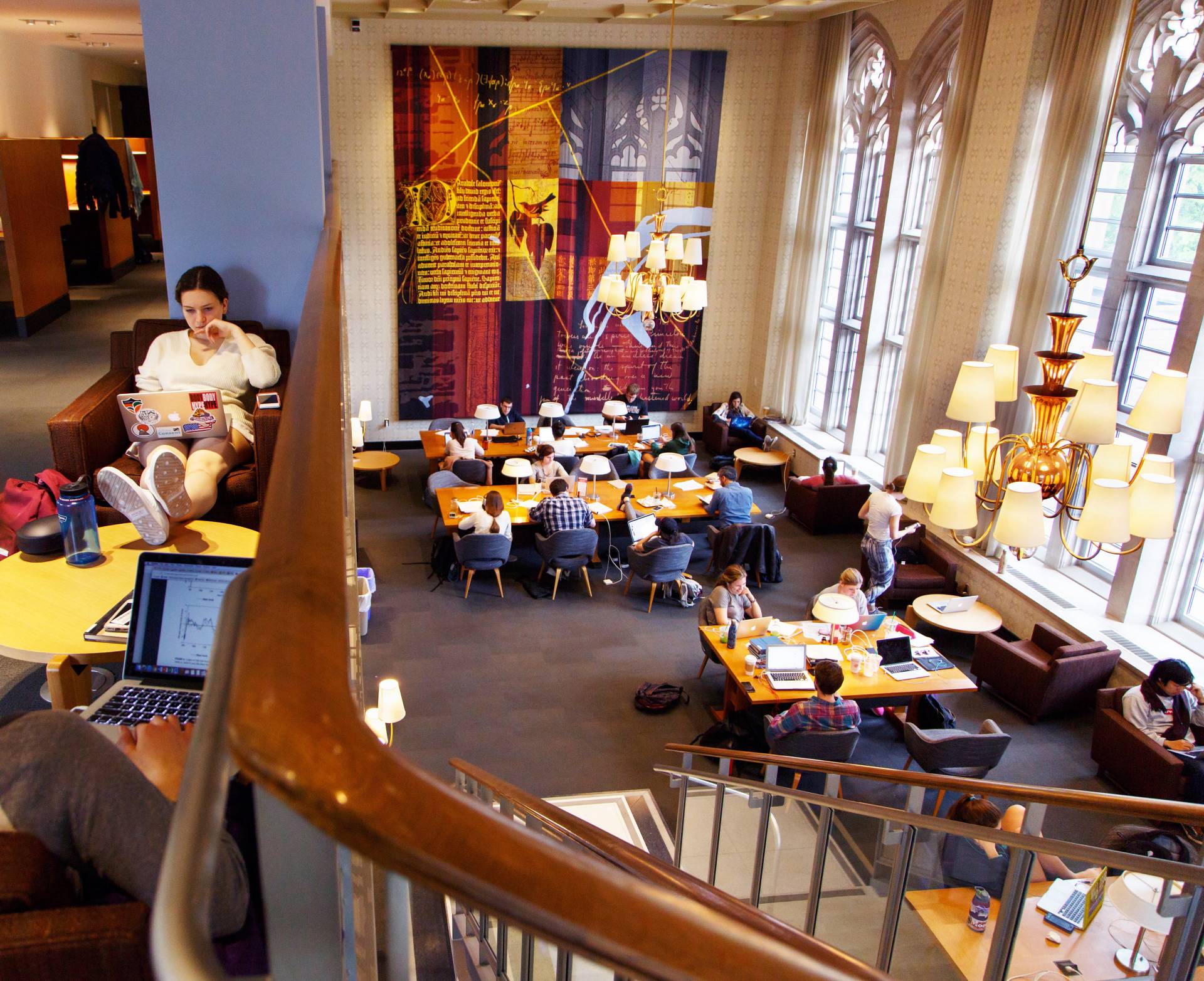
Students study in the William Elfers Reading Room in Firestone Library. Princeton University Architect Ron McCoy said the original Firestone building and the renovated interior “are dedicated to creating an atmosphere of a ‘humanistic laboratory’ that provides spaces of comfort and delight and supports opportunities for inspiration and contemplation.”
Renovation highlights
While the classic collegiate Gothic exterior of Firestone has been maintained, the renovation vastly changed the 430,000-square-foot interior. (Additions to the original building were previously made in 1971 and 1988.)
Stepping inside Firestone Library today, visitors and patrons are now greeted with natural light cascading into open spaces where glass walls reflect students studying in small groups, tucked away in favorite hideaway spots, or sprawled on comfortable couches.
Multiple floors above and below offer many more unexpected and unique spaces for research, studying and group work — all of which have been thoughtfully designed to accommodate the needs of today’s scholars.
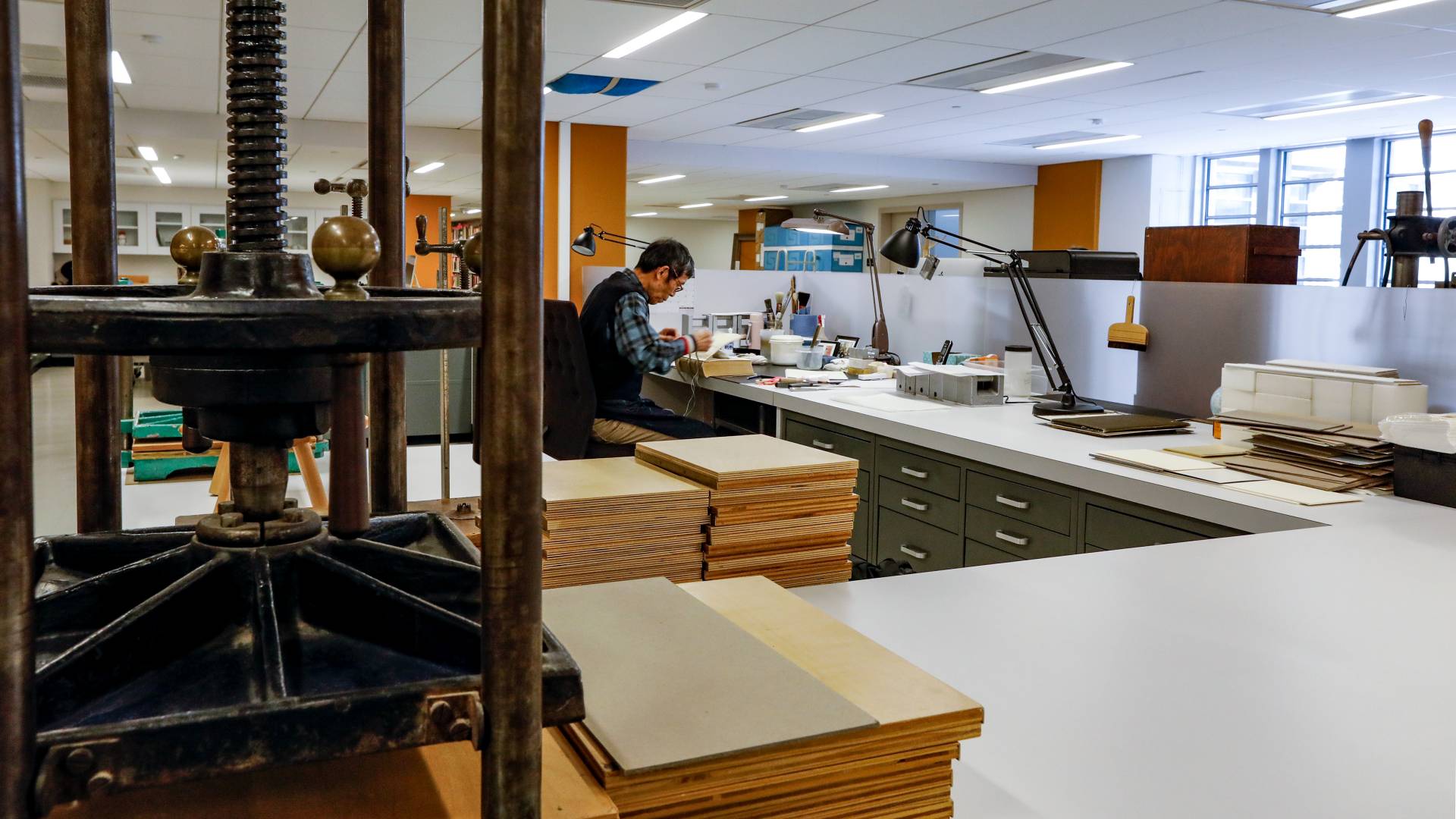
Firestone Library’s conservation lab supports the stewardship of collections, carefully maintaining and preserving materials for today’s scholars and future generations.
“This is an exciting time to be at the helm of one of the world’s greatest research libraries,” said Anne Jarvis, the Robert H. Taylor 1930 University Librarian. “The speed and scale of change facing academic libraries in recent years has been unprecedented. We are moving beyond the concept of a library as a finite place with traditional collections to that of a library as a partner in research, teaching and learning. Having state-of-the-art facilities is essential to providing expert guidance, discoverability and access to the world’s rapidly evolving knowledge resources.”
Since joining the library in fall of 2016, Jarvis has spearheaded the creation of PUL’s first mission and vision statements and five key strategic priorities. The new facilities are supporting PUL’s strategic priorities in myriad ways. Highlights include:
- Rerouted navigation and compact shelving, allowing for additional study and work spaces while maintaining the same number of books available at Firestone Library.
- Technologically equipped classrooms with e-learning capabilities, which offer places for faculty to teach using collections and allow library specialists to hold workshops on topics from information literacy to research data management.
- High-level security and environmentally controlled storage facilities in Rare Books and Special Collections, which provide secure access to materials that range from an Egyptian Book of the Dead (circa 1250 BCE) to the papers of Nobel laureate Toni Morrison, Princeton’s Robert F. Goheen Professor in the Humanities, Emeritus.
- A digital imaging studio that enables expanded digitization of book and other library materials, making it possible for people around the world to access library materials online for free.
- A conservation lab that supports the stewardship of collections, carefully maintaining and preserving materials for today’s scholars and future generations.
- Reconfigured service areas to support shared collections initiatives.
- Centralized librarian office locations to support providing interdisciplinary research guidance to scholars at all levels.
- Graduate study rooms located near core subject collections.
- A new gallery, the Ellen and Leonard Milberg Gallery, that provides museum-quality exhibition spaces (including moving walls and interactive digital capabilities). The Milberg Gallery provides visitors an opportunity to explore library collection items firsthand.
The Milberg Gallery and the Cotsen Children’s Library are both open to the public. During the renovation, the Cotsen Children’s Library underwent system upgrades while maintaining its popular and imaginative décor.
In addition to Princeton faculty, graduate students and undergraduates, Firestone’s collections are used by scholars and researchers all over the world. Princeton University Library’s holdings include 10 million printed volumes, 2 million located in Firestone, as well as 5 million manuscripts, 400,000 rare or significant printed works, thousands of journals, and 2 million non-print items in over 200 languages. PUL also provides onsite and remote access to extensive collections of databases, digital text, data and images.
1
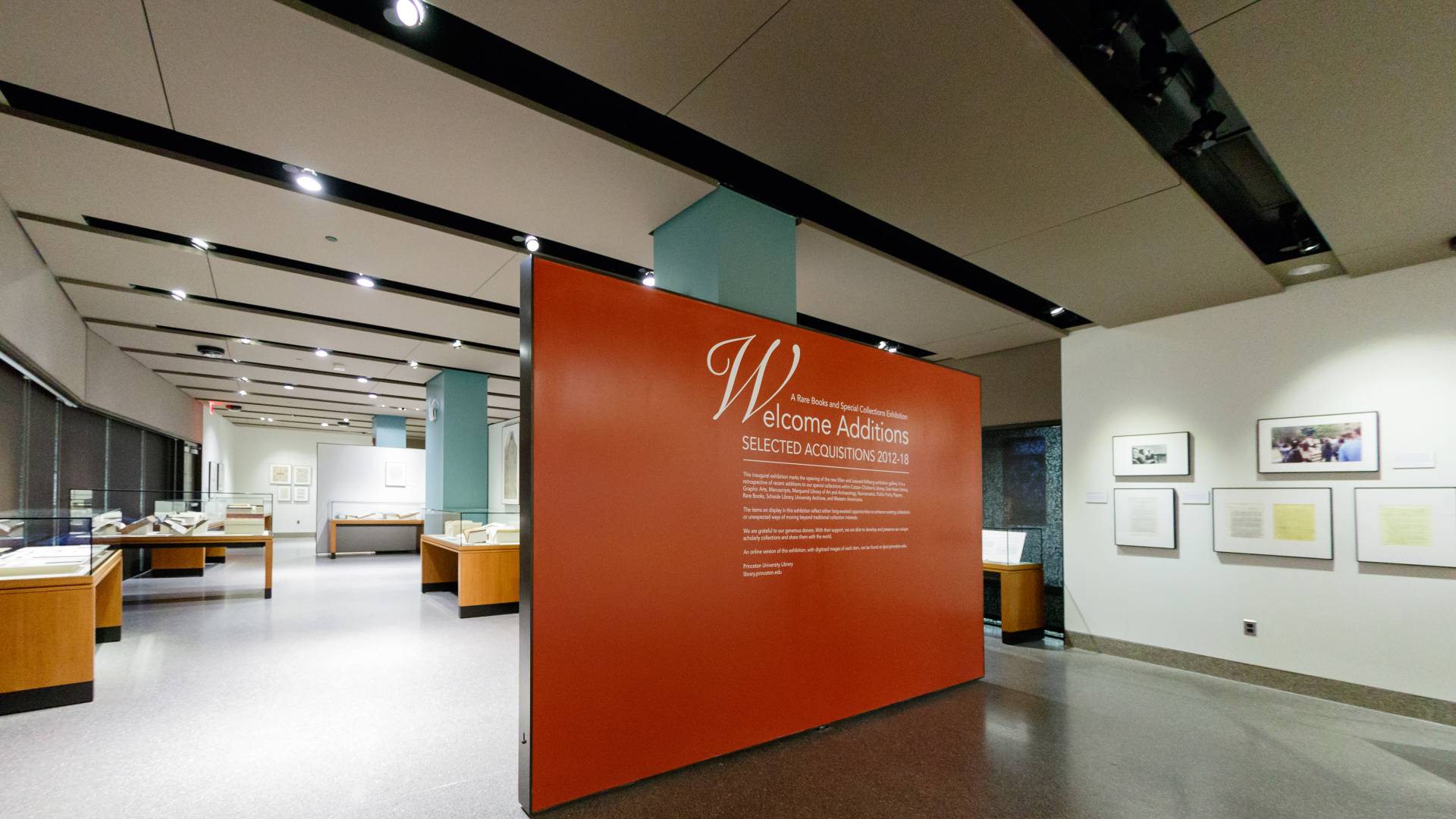
2
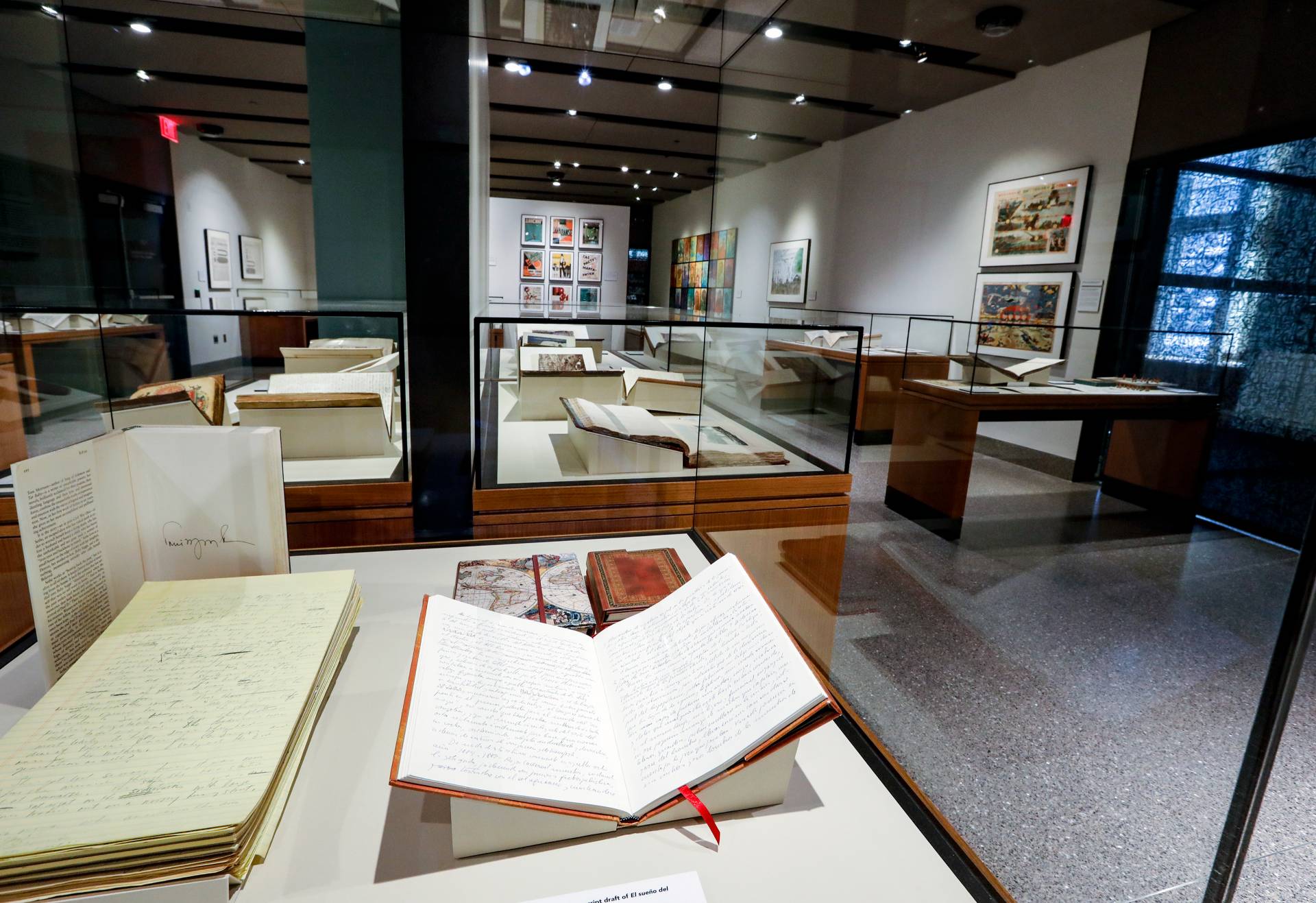
1
A new gallery, the Ellen and Leonard Milberg Gallery, provides museum-quality exhibition spaces inside Firestone Library. The gallery is free and open to the public daily from 12 p.m. to 6 p.m.
2
Now on view in the Milberg Gallery is the exhibit “Welcome Additions: Selected Acquisitions 2012-18.” It is a retrospective of the Princeton University Library’s recent additions to its special collections. Shown are handwritten materials of two Nobel laureates in literature who have taught at Princeton: edits made by Toni Morrison to a draft of her novel “Beloved” (left), and a draft of “El sueño del Celta” by Mario Vargas Llosa.
A Firestone that brings the library into the future
Given Firestone’s centrality to teaching and research at Princeton, renovation work was done in multiple phases so the building could remain open.
“One of the greatest challenges during this renovation was undergoing construction while patrons continued to use the library,” said Director of Library Finance and Administration Jeffrey Rowlands. “As PUL’s main library of nine campus locations, keeping Firestone open during the renovation was important to provide continuous research services to our patrons. It required extensive detailed planning and the ability to be flexible.”
Rowlands said one of the most rewarding parts of the renovation was Princeton’s commitment to making Firestone more energy efficient. Throughout the building, new systems include lighting sensors for dimming lights, thermally insulated windows with UV control glazing, chilled beam technology for energy-efficient heating and cooling, a green roof, LED light fixtures, and more. Overall these measures have ensured that PUL’s energy use has been significantly reduced.
Former University Librarian Karin Trainer, Jarvis, Rowlands and other library colleagues worked closely with numerous campus partners throughout the project: the Office of the President, Office of Capital Projects, Office of the University Architect, Facilities and many others. They also worked closely with Massimino Building Corporation, the national architecture firm Shepley Bulfinch and design architect Frederick Fisher and Partners.
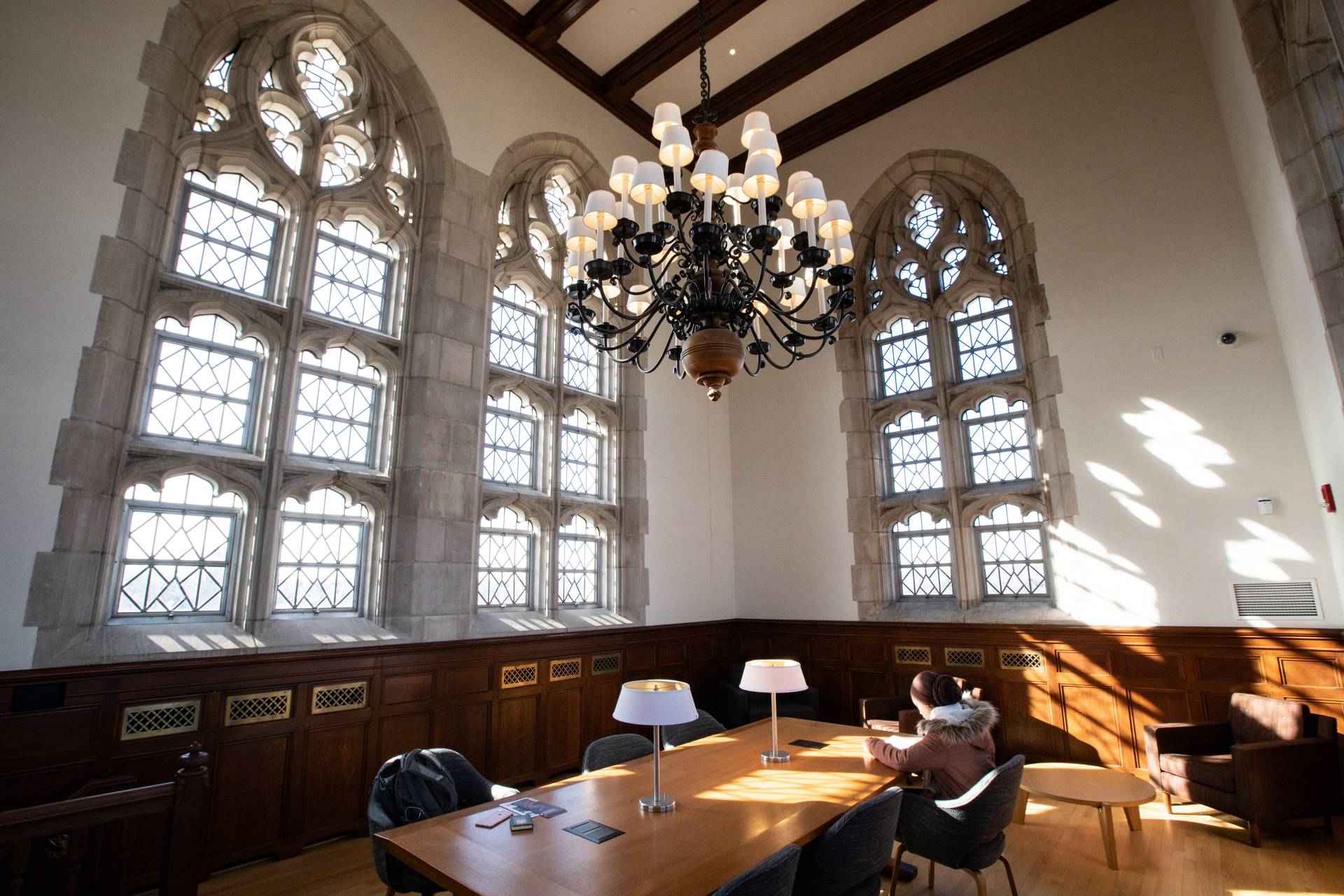
Multiple floors of the newly renovated Firestone Library offer unexpected and unique spaces for students to study and faculty to conduct research. In addition to revamping study and research areas, the renovation incorporated a number of sustainable features, greatly improving the energy-efficiency of the building.
“The Firestone Library renovation project has been a monumental effort,” said Princeton University Architect Ron McCoy. “It is more than a renovation; it is a recommitment to the themes that inspired the original building, which are no more than to encourage access to the use of books and, as time has changed, the broad range of technologies that support a liberal arts education. The original building, and the renovation, are dedicated to creating an atmosphere of a ‘humanistic laboratory’ that provides spaces of comfort and delight and supports opportunities for inspiration and contemplation.”
One measure of success for the renovation project, Rowlands said, is increased usage of patrons. During the past five years, Firestone has experienced a nearly 63 percent growth in the number of people coming to the library.
Princeton University Library is now uniquely positioned to embrace the future.
“In doing so, we will need to embrace a continuing process of creative evolution,” Jarvis said. As technology evolves and pedagogy changes, she added, “we are called upon to work with colleagues from around the world to find solutions for the organization and dissemination of information — especially as we work with new generations of students.”
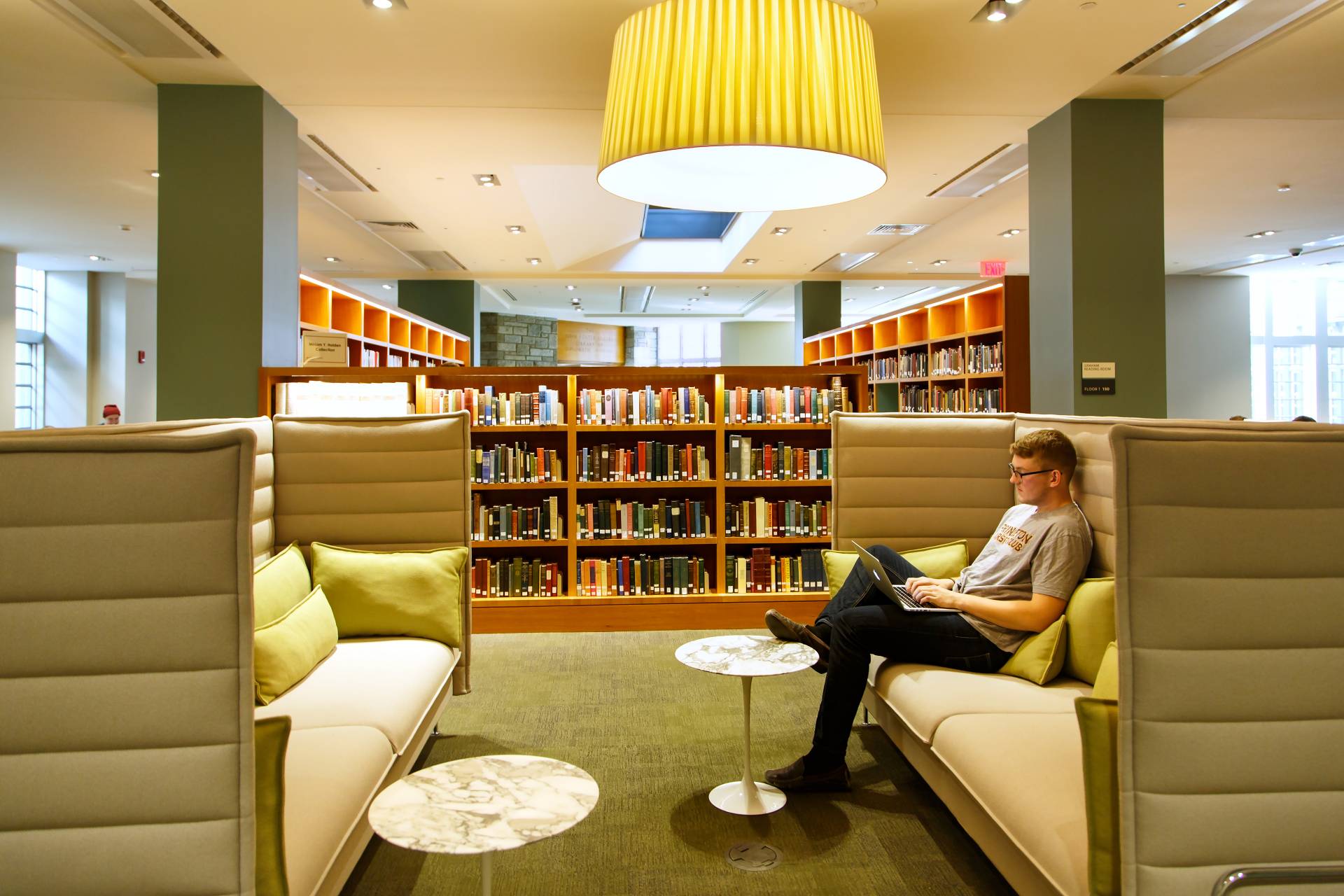
A student works in the Thomas-Graham Reading Room, which features new furniture and lighting designs.
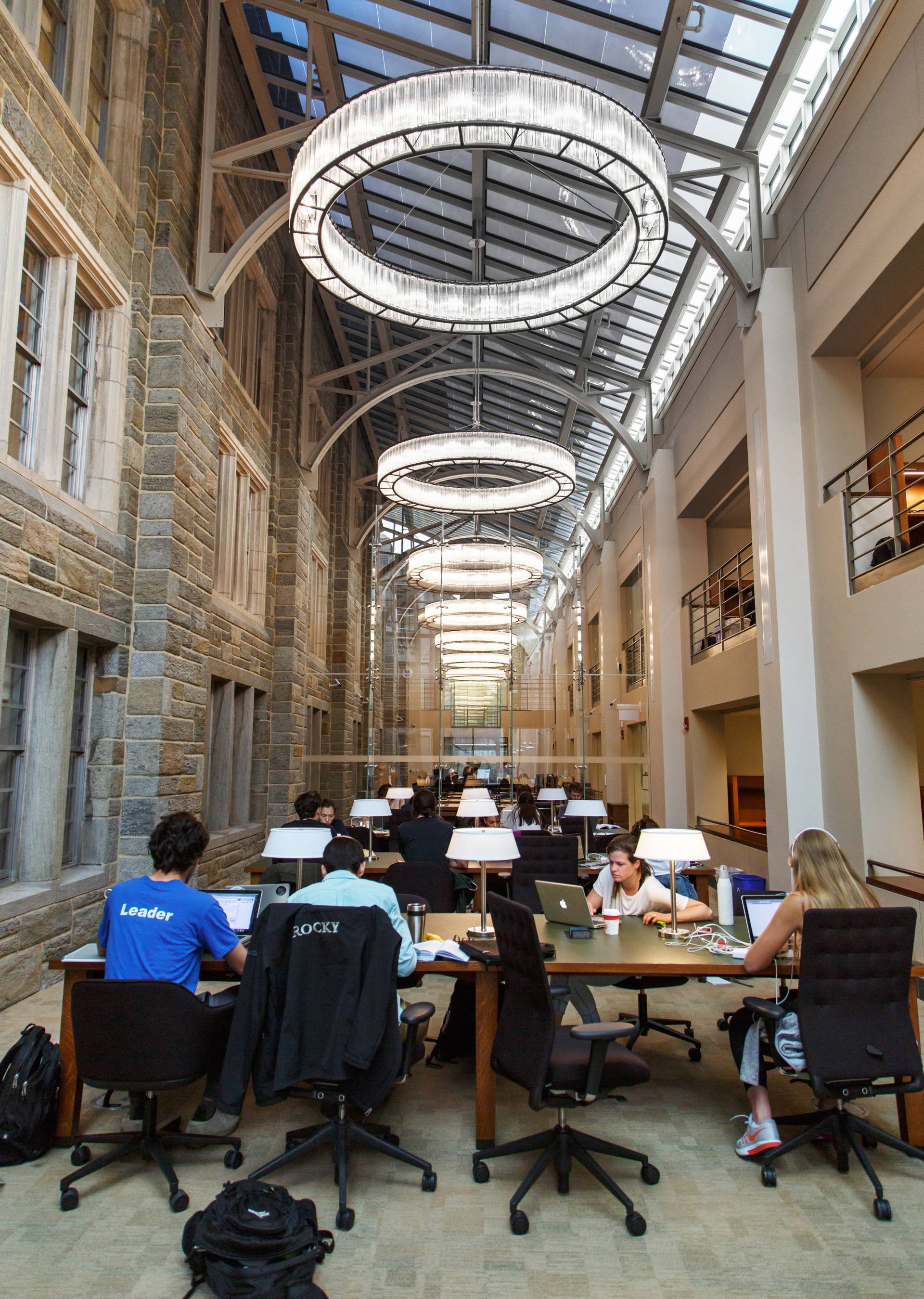
The Rare Books and Special Collections Reading Room features a soaring glass ceiling lined with circular chandeliers.





































